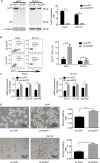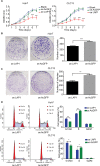Liver-enriched activator protein 1 as an isoform of CCAAT/enhancer-binding protein beta suppresses stem cell features of hepatocellular carcinoma
- PMID: 29731667
- PMCID: PMC5927340
- DOI: 10.2147/CMAR.S160172
Liver-enriched activator protein 1 as an isoform of CCAAT/enhancer-binding protein beta suppresses stem cell features of hepatocellular carcinoma
Abstract
Purpose: Liver cancer stem cells (CSCs) are known to be associated with the development, survival, proliferation, metastasis, and recurrence of liver tumors. The aim of this study was to investigate the association of liver-enriched activator protein 1 (LAP1) with hepatocellular carcinoma (HCC) and liver CSCs (LCSCs) and explore the impact of LAP1 on LCSCs.
Materials and methods: Differences in LAP1 expression in liver cancer tissues versus matched para-tumoral liver tissues and LCSCs versus non-CSCs were analyzed by Western blotting, real-time polymerase chain reaction, immunohistochemistry, and flow cytometry. The effect of LAP1 on liver cancer cells was evaluated by the expression of CSC markers, oncosphere formation, proliferation, migration, and invasion in vitro. Cell cycle distribution and the number of apoptotic cells were analyzed to assess cell cycle and cell apoptosis. Furthermore, a mouse subcutaneous tumor implant model was established to explore the role of LAP1 in the development of HCC in vivo. Finally, the expression of CSC markers in paraffin-embedded sections was evaluated by immunofluorescence.
Results: LAP1 was weakly expressed in HCC tumors and cell lines and even weaker in LCSCs. LAP1 inhibited the expression of stem cell-associated genes and reduced the abilities of oncosphere formation, proliferation, migration, and invasion in vitro. Cell cycle assay revealed that LAP1 induced G1/G0 arrest. Furthermore, LAP1 decreased subcutaneous tumor-formation ability and the expression of CSC markers and Ki67 in vivo.
Conclusion: LAP1 suppressed the stem cell features of HCC, indicating that it possessed an antitumor effect in liver cancer, both in vitro and in vivo; therefore, LAP1 may prove to be a potential target in liver CSC-targeted therapy.
Keywords: HCC; LAP1; hepatocellular carcinoma; liver cancer stem cell; liver-enriched activator protein 1.
Conflict of interest statement
Disclosure The authors report no conflicts of interest in this work.
Figures






Similar articles
-
Orosomucoid 2 inhibits tumor metastasis and is upregulated by CCAAT/enhancer binding protein β in hepatocellular carcinomas.Oncotarget. 2015 Jun 30;6(18):16106-19. doi: 10.18632/oncotarget.3867. Oncotarget. 2015. PMID: 25965830 Free PMC article.
-
Efficacy of using cancer stem cell markers in isolating and characterizing liver cancer stem cells.Stem Cells Dev. 2013 Oct 1;22(19):2655-64. doi: 10.1089/scd.2012.0703. Epub 2013 Jun 8. Stem Cells Dev. 2013. PMID: 23638793 Free PMC article.
-
Hovenia dulcis Suppresses the Growth of Huh7-Derived Liver Cancer Stem Cells by Inducing Necroptosis and Apoptosis and Blocking c-MET Signaling.Cells. 2023 Dec 21;13(1):22. doi: 10.3390/cells13010022. Cells. 2023. PMID: 38201226 Free PMC article.
-
Cancer stem cells in hepatocellular carcinoma: an overview and promising therapeutic strategies.Ther Adv Med Oncol. 2018 Dec 21;10:1758835918816287. doi: 10.1177/1758835918816287. eCollection 2018. Ther Adv Med Oncol. 2018. PMID: 30622654 Free PMC article. Review.
-
Targeting liver cancer stem cells for the treatment of hepatocellular carcinoma.Therap Adv Gastroenterol. 2019 Jan 22;12:1756284818821560. doi: 10.1177/1756284818821560. eCollection 2019. Therap Adv Gastroenterol. 2019. PMID: 30719075 Free PMC article. Review.
Cited by
-
Aberrant expression of alternative isoforms of transcription factors in hepatocellular carcinoma.World J Hepatol. 2018 Oct 27;10(10):645-661. doi: 10.4254/wjh.v10.i10.645. World J Hepatol. 2018. PMID: 30386458 Free PMC article. Review.
-
LKB1 suppresses glioma cell invasion via NF-κB/Snail signaling repression.Onco Targets Ther. 2019 Apr 2;12:2451-2463. doi: 10.2147/OTT.S193736. eCollection 2019. Onco Targets Ther. 2019. PMID: 31040689 Free PMC article.
-
Transcription Factors in Cancer: When Alternative Splicing Determines Opposite Cell Fates.Cells. 2020 Mar 20;9(3):760. doi: 10.3390/cells9030760. Cells. 2020. PMID: 32244895 Free PMC article. Review.
-
Network Pharmacology-Based Approach to Investigate the Molecular Targets of Sinomenine for Treating Breast Cancer.Cancer Manag Res. 2021 Feb 9;13:1189-1204. doi: 10.2147/CMAR.S282684. eCollection 2021. Cancer Manag Res. 2021. PMID: 33603465 Free PMC article.
-
Sinomenine Inhibits the Growth of Ovarian Cancer Cells Through the Suppression of Mitosis by Down-Regulating the Expression and the Activity of CDK1.Onco Targets Ther. 2021 Feb 5;14:823-834. doi: 10.2147/OTT.S284261. eCollection 2021. Onco Targets Ther. 2021. PMID: 33574676 Free PMC article.
References
-
- Torre LA, Bray F, Siegel RL, Ferlay J, Lortet-Tieulent J, Jemal A. Global cancer statistics, 2012. CA Cancer J Clin. 2015;65(2):87–108. - PubMed
-
- Siegel RL, Miller KD, Jemal A. Cancer statistics, 2016. CA Cancer J Clin. 2016;66(1):7–30. - PubMed
-
- Maluccio M, Covey A. Recent progress in understanding, diagnosing, and treating hepatocellular carcinoma. CA Cancer J Clin. 2012;62(6):394–399. - PubMed
-
- Hao J, Zhang Y, Deng M, et al. MicroRNA control of epithelial-mesenchymal transition in cancer stem cells. Int J Cancer. 2014;135(5):1019–1027. - PubMed
LinkOut - more resources
Full Text Sources
Other Literature Sources
Research Materials

